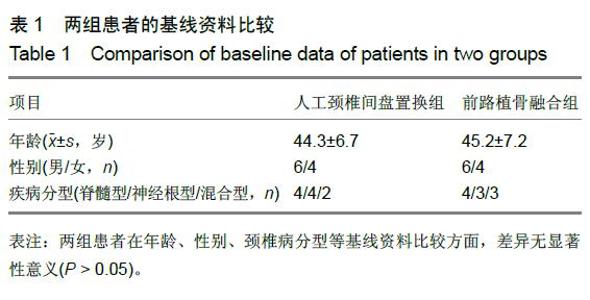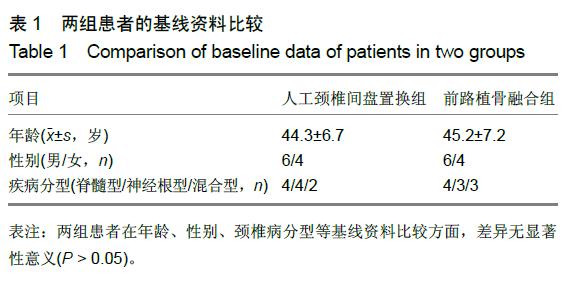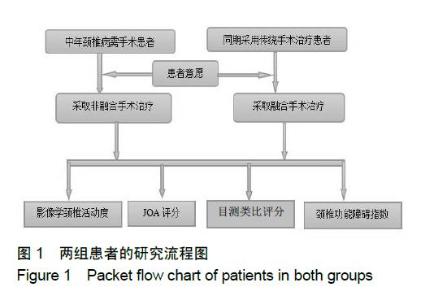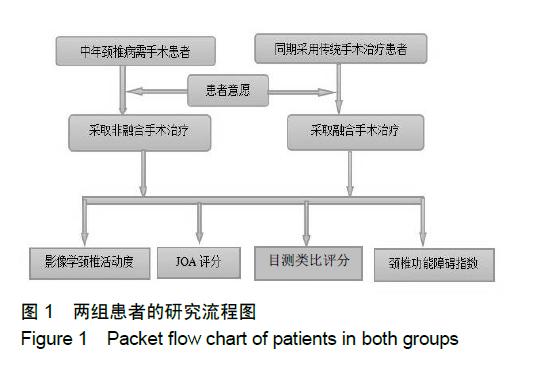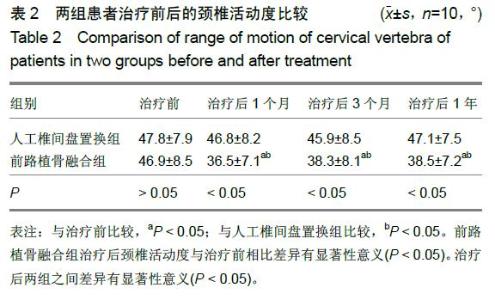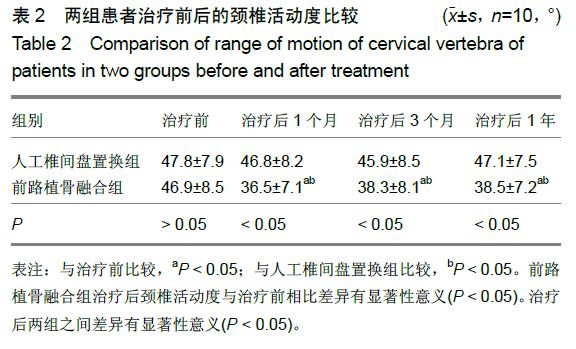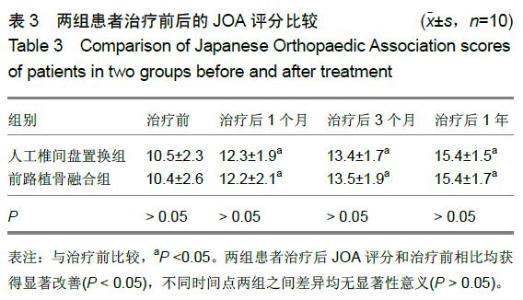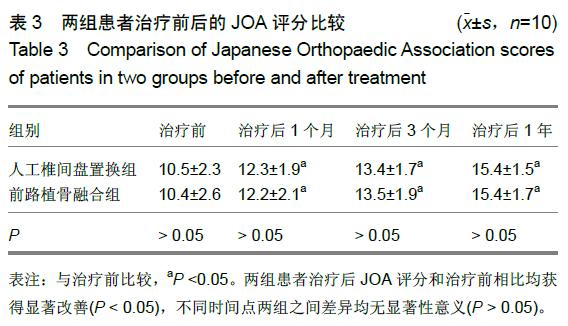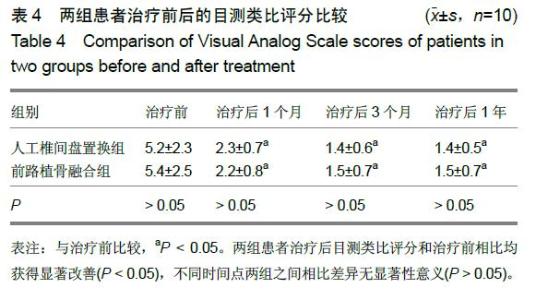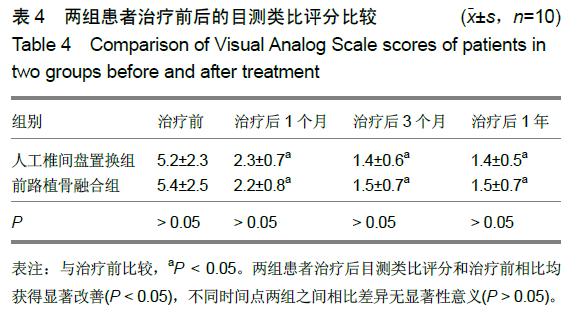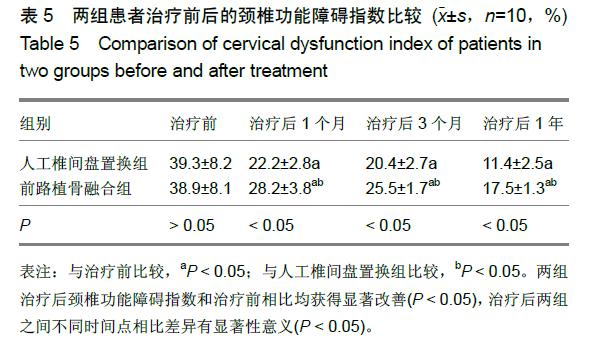Chinese Journal of Tissue Engineering Research ›› 2015, Vol. 19 ›› Issue (48): 7717-7723.doi: 10.3969/j.issn.2095-4344.2015.48.002
Previous Articles Next Articles
Cervical disc replacement and anterior interbody fusion in the repair of middle-aged patients with cervical spondylosis: cervical function and range of motion
Jiang Xin-xiang1, Xu Hai-dong2, Lu Xiao1
- 1Department of Orthopedics, Dongtai People’s Hospital, Dongtai 224200, Jiangsu Province, China; 2Department of Orthopedics, Nanjing General Hospital of Nanjing Military Area Command of Chinese PLA, Nanjing 210002, Jiangsu Province, China
-
Received:2015-08-31Online:2015-11-26Published:2015-11-26 -
Contact:Lu Xiao, Associate chief physician, Department of Orthopedics, Dongtai People’s Hospital, Dongtai 224200, Jiangsu Province, China -
About author:Jiang Xin-xiang, Attending physician, Department of Orthopedics, Dongtai People’s Hospital, Dongtai 224200, Jiangsu Province, China
CLC Number:
Cite this article
Jiang Xin-xiang, Xu Hai-dong, Lu Xiao. Cervical disc replacement and anterior interbody fusion in the repair of middle-aged patients with cervical spondylosis: cervical function and range of motion[J]. Chinese Journal of Tissue Engineering Research, 2015, 19(48): 7717-7723.
share this article
|
[1] Tabaraee E, Ahn J, Bohl DD, et al. The Impact of Worker's Compensation Claims on Outcomes and Costs Following an Anterior Cervical Discectomy and Fusion.Spine (Phila Pa 1976). 2015;40(12):948-953.
[2] Dong J, Lu M, Lu T, et al. Meta-Analysis Comparing Zero-Profile Spacer and Anterior Plate in Anterior Cervical Fusion.PLoS One. 2015;10(6):e0130223
[3] Epstein NE, Roberts R, Collins J. Operative costs, reasons for operative waste, and vendor credit replacement in spinal surgery. Surg Neurol Int. 2015;6(Suppl 4):S186-189.
[4] Sun Y, Zhao YB, Pan SF, et al. Comparison of adjacent segment degeneration five years after single level cervical fusion and cervical arthroplasty: a retrospective controlled study.Chin Med J (Engl). 2012;125(22):3939-3941.
[5] Davis RJ, Kim KD, Hisey MS,et al.Cervical total disc replacement with the Mobi-C cervical artificial disc compared with anterior discectomy and fusion for treatment of 2-level symptomatic degenerative disc disease: a prospective, randomized, controlled multicenter clinical trial: clinical article.J Neurosurg Spine. 2013;19(5):532-545.
[6] Liu P, Zhao J, Liu F, et al.A novel operative approach for the treatment of old distractive flexion injuries of subaxial cervical spine.Spine (Phila Pa 1976). 2008;33(13):1459-1464.
[7] Heidecke V, Burkert W, Brucke M, et al.Intervertebral disc replacement for cervical degenerative disease--clinical results and functional outcome at two years in patients implanted with the Bryan cervical disc prosthesis. Acta Neurochir (Wien). 2008;150(5):453-459.
[8] Zindrick MR, Spratt KF.Point of view: 5-year results of the FDA study. Spine (Phila Pa 1976). 2013;38(3):210.
[9] Koller H, Meier O, Zenner J, et al. In vivo analysis of cervical kinematics after implantation of a minimally constrained cervical artificial disc replacement. Eur Spine J. 2013;22(4): 747-758.
[10] de Beer N, Scheffer C.Reducing subsidence risk by using rapid manufactured patient-specific intervertebral disc implants. Spine J. 2012;12(11):1060-1066.
[11] Zigler JE, Delamarter R, Murrey D,et al.ProDisc-C and anterior cervical discectomy and fusion as surgical treatment for single-level cervical symptomatic degenerative disc disease: five-year results of a Food and Drug Administration study. Spine (Phila Pa 1976). 2013;38(3):203-209.
[12] Jawahar A, Nunley P.Total disc arthroplasty and anterior cervical discectomy and fusion in cervical spine: competitive or complimentary? Review of the literature. Global Spine J. 2012;2(3):183-186
[13] Tsermoulas G, Bhattathiri PS.Anterior migration of prosthesis following cervical arthroplasty. Br J Neurosurg. 2013;27(1): 132-133.
[14] Ding C, Hong Y, Liu H, et al.Intermediate clinical outcome of Bryan Cervical Disc replacement for degenerative disk disease and its effect on adjacent segment disks. Orthopedics. 2012;35(6):e909-916.
[15] Yang B, Li H, Zhang T,et al.The incidence of adjacent segment degeneration after cervical disc arthroplasty (CDA): a meta analysis of randomized controlled trials. PLoS One. 2012;7(4):e35032.
[16] Wu JC, Huang WC, Tsai HW, et al.Differences between 1- and 2-level cervical arthroplasty: more heterotopic ossification in 2-level disc replacement: Clinical article. J Neurosurg Spine. 2012;16(6):594-600.
[17] Tu TH, Wu JC, Fay LY, et al.Vertebral body split fracture after a single-level cervical total disc replacement. J Neurosurg Spine. 2012;16(3):231-235.
[18] Xia XP, Chen HL, Cheng HB.Prevalence of adjacent segment degeneration after spine surgery: a systematic review and meta-analysis. Spine (Phila Pa 1976). 2013; 38(7):597-608.
[19] Harrod CC, Hilibrand AS, Fischer DJ, et al.Adjacent segment pathology following cervical motion-sparing procedures or devices compared with fusion surgery: a systematic review. Spine (Phila Pa 1976). 2012;37(22 Suppl):S96-S112.
[20] Lebl DR, Cammisa FP Jr, Girardi FP, et al.The mechanical performance of cervical total disc replacements in vivo: prospective retrieval analysis of prodisc-C devices. Spine (Phila Pa 1976). 2012;37(26):2151-2160.
[21] Aghayev E, Bärlocher C, Sgier F, et al.Five-year results of cervical disc prostheses in the SWISSspine registry. Eur Spine J. 2013;22(8):1723-1730.
[22] Ryu WH, Kowalczyk I, Duggal N.Long-term kinematic analysis of cervical spine after single-level implantation of Bryan cervical disc prosthesis. Spine J. 2013;13(6): 628-634.
[23] Yi S, Shin DA, Kim KN, et al.The predisposing factors for the heterotopic ossification after cervical artificial disc replacement. Spine J. 2013;13(9):1048-1054.
[24] Helgeson MD, Bevevino AJ, Hilibrand AS.Update on the evidence for adjacent segment degeneration and disease. Spine J. 2013;13(3):342-351.
[25] Yin S, Yu X, Zhou S, et al.Is cervical disc arthroplasty superior to fusion for treatment of symptomatic cervical disc disease? A meta-analysis. Clin Orthop Relat Res. 2013;471(6): 1904-1919.
[26] Cason GW, Herkowitz HN. Cervical intervertebral disc replacement. J Bone Joint Surg Am. 2013;95(3):279-285.
[27] Viezens L, Schaefer C, Beyerlein J, et al.An incomplete paraplegia following the dislocation of an artificial cervical total disc replacement. J Neurosurg Spine. 2013;18(3): 255-259.
[28] Nunley PD, Jawahar A, Cavanaugh DA,et al. Symptomatic adjacent segment disease after cervical total disc replacement: re-examining the clinical and radiological evidence with established criteria. Spine J. 2013;13(1): 5-12.
[29] Xing D, Ma XL, Ma JX,et al.A meta-analysis of cervical arthroplasty compared to anterior cervical discectomy and fusion for single-level cervical disc disease. J Clin Neurosci. 2013;20(7):970-978.
[30] Qin J, He X, Wang D,et al.Artificial cervical vertebra and intervertebral complex replacement through the anterior approach in animal model: a biomechanical and in vivo evaluation of a successful goat model. PLoS One. 2012;7(12): e52910.
[31] McDonald CP, Chang V, McDonald M,et al.Three-dimensional motion analysis of the cervical spine for comparison of anterior cervical decompression and fusion versus artificial disc replacement in 17 patients: clinical article. J Neurosurg Spine. 2014;20(3):245-255.
[32] Verma K, Gandhi SD, Maltenfort M,et al. Rate of adjacent segment disease in cervical disc arthroplasty versus single-level fusion: meta-analysis of prospective studies. Spine (Phila Pa 1976). 2013;38(26):2253-2257.
[33] Vaccaro A, Beutler W, Peppelman W, et al.Clinical outcomes with selectively constrained SECURE-C cervical disc arthroplasty: two-year results from a prospective, randomized, controlled, multicenter investigational device exemption study. Spine (Phila Pa 1976). 2013;38(26):2227-2239.
[34] Wenger M, Markwalder TM. Posterior decompression salvages Bryan total disc arthroplasty in post-operatively recurrent uncoforaminal stenosis. J Clin Neurosci. 2014; 21(5):741-744.
[35] Nandyala SV, Marquez-Lara A, Fineberg SJ, et al. Comparison between cervical total disc replacement and anterior cervical discectomy and fusion of 1 to 2 levels from 2002 to 2009. Spine (Phila Pa 1976). 2014;39(1):53-57. |
| [1] | Chen Ziyang, Pu Rui, Deng Shuang, Yuan Lingyan. Regulatory effect of exosomes on exercise-mediated insulin resistance diseases [J]. Chinese Journal of Tissue Engineering Research, 2021, 25(25): 4089-4094. |
| [2] | Chen Yang, Huang Denggao, Gao Yuanhui, Wang Shunlan, Cao Hui, Zheng Linlin, He Haowei, Luo Siqin, Xiao Jingchuan, Zhang Yingai, Zhang Shufang. Low-intensity pulsed ultrasound promotes the proliferation and adhesion of human adipose-derived mesenchymal stem cells [J]. Chinese Journal of Tissue Engineering Research, 2021, 25(25): 3949-3955. |
| [3] | Yang Junhui, Luo Jinli, Yuan Xiaoping. Effects of human growth hormone on proliferation and osteogenic differentiation of human periodontal ligament stem cells [J]. Chinese Journal of Tissue Engineering Research, 2021, 25(25): 3956-3961. |
| [4] | Sun Jianwei, Yang Xinming, Zhang Ying. Effect of montelukast combined with bone marrow mesenchymal stem cell transplantation on spinal cord injury in rat models [J]. Chinese Journal of Tissue Engineering Research, 2021, 25(25): 3962-3969. |
| [5] | Gao Shan, Huang Dongjing, Hong Haiman, Jia Jingqiao, Meng Fei. Comparison on the curative effect of human placenta-derived mesenchymal stem cells and induced islet-like cells in gestational diabetes mellitus rats [J]. Chinese Journal of Tissue Engineering Research, 2021, 25(25): 3981-3987. |
| [6] | Hao Xiaona, Zhang Yingjie, Li Yuyun, Xu Tao. Bone marrow mesenchymal stem cells overexpressing prolyl oligopeptidase on the repair of liver fibrosis in rat models [J]. Chinese Journal of Tissue Engineering Research, 2021, 25(25): 3988-3993. |
| [7] | Liu Jianyou, Jia Zhongwei, Niu Jiawei, Cao Xinjie, Zhang Dong, Wei Jie. A new method for measuring the anteversion angle of the femoral neck by constructing the three-dimensional digital model of the femur [J]. Chinese Journal of Tissue Engineering Research, 2021, 25(24): 3779-3783. |
| [8] | Meng Lingjie, Qian Hui, Sheng Xiaolei, Lu Jianfeng, Huang Jianping, Qi Liangang, Liu Zongbao. Application of three-dimensional printing technology combined with bone cement in minimally invasive treatment of the collapsed Sanders III type of calcaneal fractures [J]. Chinese Journal of Tissue Engineering Research, 2021, 25(24): 3784-3789. |
| [9] | Qian Xuankun, Huang Hefei, Wu Chengcong, Liu Keting, Ou Hua, Zhang Jinpeng, Ren Jing, Wan Jianshan. Computer-assisted navigation combined with minimally invasive transforaminal lumbar interbody fusion for lumbar spondylolisthesis [J]. Chinese Journal of Tissue Engineering Research, 2021, 25(24): 3790-3795. |
| [10] | Hu Jing, Xiang Yang, Ye Chuan, Han Ziji. Three-dimensional printing assisted screw placement and freehand pedicle screw fixation in the treatment of thoracolumbar fractures: 1-year follow-up [J]. Chinese Journal of Tissue Engineering Research, 2021, 25(24): 3804-3809. |
| [11] | Shu Qihang, Liao Yijia, Xue Jingbo, Yan Yiguo, Wang Cheng. Three-dimensional finite element analysis of a new three-dimensional printed porous fusion cage for cervical vertebra [J]. Chinese Journal of Tissue Engineering Research, 2021, 25(24): 3810-3815. |
| [12] | Wang Yihan, Li Yang, Zhang Ling, Zhang Rui, Xu Ruida, Han Xiaofeng, Cheng Guangqi, Wang Weil. Application of three-dimensional visualization technology for digital orthopedics in the reduction and fixation of intertrochanteric fracture [J]. Chinese Journal of Tissue Engineering Research, 2021, 25(24): 3816-3820. |
| [13] | Sun Maji, Wang Qiuan, Zhang Xingchen, Guo Chong, Yuan Feng, Guo Kaijin. Development and biomechanical analysis of a new anterior cervical pedicle screw fixation system [J]. Chinese Journal of Tissue Engineering Research, 2021, 25(24): 3821-3825. |
| [14] | Lin Wang, Wang Yingying, Guo Weizhong, Yuan Cuihua, Xu Shenggui, Zhang Shenshen, Lin Chengshou. Adopting expanded lateral approach to enhance the mechanical stability and knee function for treating posterolateral column fracture of tibial plateau [J]. Chinese Journal of Tissue Engineering Research, 2021, 25(24): 3826-3827. |
| [15] | Zhu Yun, Chen Yu, Qiu Hao, Liu Dun, Jin Guorong, Chen Shimou, Weng Zheng. Finite element analysis for treatment of osteoporotic femoral fracture with far cortical locking screw [J]. Chinese Journal of Tissue Engineering Research, 2021, 25(24): 3832-3837. |
| Viewed | ||||||
|
Full text |
|
|||||
|
Abstract |
|
|||||
